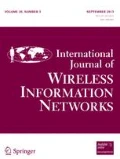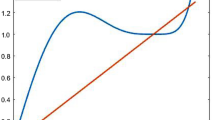Abstract
Exact, closed-form, error probability expressions for noncoherent M-ary frequency-shift-keying (MFSK) systems that employ postdetection equal-gain diversity over Rayleigh, Rician, and Nakagami-m channels are derived using a Laplace derivative formula. Both independent and generically correlated fading cases are considered. For independent fading, closed-form solutions are also derived for both Nakagami-q fading (either with identical or dissimilar fading statistics) and mixed fading cases. Previous results are shown to be specific instances of our general expressions. In addition, a concise, derivative formula is derived for calculating the bit error rate of square-law detected multichannel binary differential phase-shift-keying (DPSK) signals. All of these expressions are applicable in many cases of practical interest and provide accurate predictions of the performance of both binary and M-ary orthogonal signaling over generalized fading channels with arbitrary parameters.
Similar content being viewed by others
References
J. G. Proakis, Digital Communications, 3rd Ed, McGraw-Hill, New York, 1995.
P. M. Hahn, Theoretical diversity in multiple frequency shift keying, IRE Trans. Communication Systems, Vol. CS-10, pp. 177–184, June 1962.
W. C. Lindsey, Error probabilities for Ricean fading multichannel reception of binary and N-ary signals, IEEE Trans. Information Theory, Vol. IT-10, pp. 339–350, October 1964.
J. F. Weng and S. H. Leung, Analysis of M-ary FSK square law combiner under Nakagami fading, Electronics Letters, Vol. 33, pp. 1671–1673, September 1997.
V. Aalo, O. Ugweje, and R. Sudhakar, Performance analysis of a DS/CDMA system with noncoherent M-ary orthogonal modulation in Nakagami fading, IEEE Trans. Vehic. Technology, Vol. 47, pp. 20–29, February 1998.
M. K. Simon and M.-S. Alouini, Bit error probability of noncoherent M-ary modulation over generalized fading channels, Journal of Communications and Networks, Vol. 1, pp. 111–117, June 1999.
L. M. Jalloul and J. M. Holtzman, Performance analysis of DS/CDMA with noncoherent M-ary orthogonal modulation in multipath fading channels, IEEE Journal on Selected Areas in Communications, Vol. SAC-12, pp. 862–870, June 1994.
A. Annamalai, C. Tellambura, and V. K. Bhargava, A general method for calculating error probabilities over fading channels, IEEE Trans. on Communications, in press.
F. Patenaude, J. H. Lodge, and J.-Y. Chouinard, Noncoherent diversity reception over Nakagami fading channels, IEEE Trans. Communications, Vol. 46, pp. 985–991, August 1998.
M. K. Simon and M.-S. Alouini, A unified approach to the probability of error for noncoherent and differentially coherent modulations over generalized fading channels, IEEE Trans. Communications, Vol. 46, pp. 1625–1638, December 1998.
C. Tellambura, Evaluation of the exact union bound for trellis coded modulations over fading channels, IEEE Transactions on Communications, Vol. 44, No. 12, pp. 1693–1699, Dec. 1996.
C. Tellambura, A. J. Mueller, and V. K. Bhargava, Analysis of M-ary phase shift keying with diversity reception for land mobile satellite channels, IEEE Transactions on Vehicular Technology, Vol. 46, pp. 910–922, Nov. 1997.
M. K. Simon and M.-S. Alouini, A unified approach to performance analysis of digital communication over generalized fading channels, Proc. IEEE, Vol. 86, pp. 1860–1877, Sept. 1998.
X. Dong, N. C. Beaulieu, and P. H. Wittke, Signal constellations for fading channels, IEEE Trans. Communications, Vol. 47, pp. 703–714, May 1999.
Crepeau, Uncoded and coded performance of MFSK and DPSK in Nakagami fading channels, IEEE Trans. Communications, Vol. 40, pp. 487–493, March 1992.
F. Lombardo and G. Fedele, Post-detection diversity in Nakagami fading channels with correlated branches, IEEE Communications Letters, Vol. 3, No. 5, pp. 132–135, May 1999.
Q. T. Zhang, Exact analysis of postdetection combining for DPSK and NFSK systems over arbitrarily correlated Nakagami channels, IEEE Trans. Communications, Vol. 46, pp. 1459–1467, November 1998.
M. Schwartz, W. R. Bennett, and S. Stein, Communication Systems and Techniques, McGraw-Hill, New York, 1966.
W. C. Y. Lee, Mobile Communications: Design Fundamentals, Wiley, New York, pp. 202–211, 1993.
I. S. Gradshteyn and I. M. Ryzhik, Table of Integrals, Series and Products, Academic Press, New York, 1995.
U. Charash, Reception through Nakagami fading multipath channels with random delays, IEEE Trans. Communications, Vol. 27, pp. 657–670, April 1979.
C. Tellambura and A. Annamalai, Tutorial notes: Analytical tools for wireless communications systems design. In 2000 IEEE Vehicular Technology Conference, Tokyo, May 2000.
Author information
Authors and Affiliations
Rights and permissions
About this article
Cite this article
Annamalai, A., Tellambura, C. A Moment-Generating Function (MGF) Derivative-Based Unified Analysis of Incoherent Diversity Reception of M-ary Orthogonal Signals over Independent and Correlated Fading Channels. International Journal of Wireless Information Networks 10, 41–56 (2003). https://doi.org/10.1023/A:1023418908192
Issue Date:
DOI: https://doi.org/10.1023/A:1023418908192



